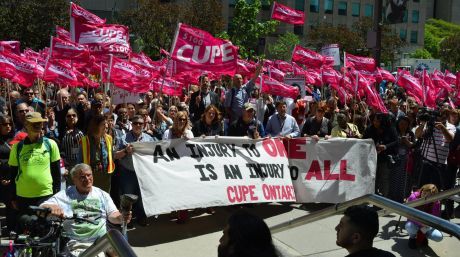Reports
You are here
Report: Injured Workers’ Day rally and march

June 17, 2017
The Ontario Network of Injured Workers’ Groups (ONIWG) held a solidarity rally and march on June 1 to mark Injured Workers’ Day. Workers and allies came out to show their support at the march, which began at Queen’s Park heading southbound. There were dozens of unions represented including large contingents from Unifor, United Steelworkers, and hundreds from the CUPE convention happening that day. Among the attendees was Fred Hudon, an injured worker advocate who has been active on this front for 56 years. Hudon lost his leg at the age of 17.
The event was held a scant two days after the major Fight for $15 and Fairness victory. Fred Hahn, president of CUPE correctly stated that the Fight for $15 victory did not come from suddenly compassionate Liberals but, “because of activists on the ground moving and mobilizing and fighting for years.”
WSIB
ONIWG and its allies coalesced around their opposition to the practices of Ontario’s Workplace Safety and Insurance Board (WSIB). This arm of Ontario’s Ministry of Labour has come under fire in recent years for forcing new policies that are aimed primarily at cost cutting, not taking care of workers. Aiden McDonald, one of the organizers of the event, said the WSIB negatively affects working families in Ontario. “Workers who have the most severe injuries, that’s where we see the most problems. The people with the most severe injuries cost the system the most. The people who need the most support get treated the worst, and they’re the ones who fall into poverty. Of injured workers who have permanent impairment, close to 50% fall into poverty.”
McDonald also described a technique WSIB uses where they “deem” a worker to have a new “phantom job” after their injury, even if they have no job or income. WSIB then calculates what this job might pay an injured worker, and reduce the benefits by that amount. WSIB has also drastically reduced the amount of accepted claims for prescription drugs and has been fighting workers in courts to prevent them from claiming benefits if they have pre-existing conditions in certain cases.
The patterns of neglect go far beyond these examples and were aired by speakers at the end of the rally outside the CUPE convention. Injured workers and union members shared their stories of hardship, resilience, and dedication in the face of injustice. One of the most moving speeches was delivered by Janice Hobbs-Martell. Her father, Jim Hobbs, had died days before from an occupation-related cause which the WSIB was unwilling to compensate for or recognize. Hobbs was a miner in Elliot Lake where aluminum-laden McIntyre powder was deliberately circulated in mines to act as a protective agent against silicosis. After two years in the mine, Hobbs developed Parkinson’s disease, a neurological disorder.
Hobbs’ case never reached the tribunal level because the WSIB enacted a negative policy (i.e. an exemption, stating what isn’t covered), which Janice contends was foresight to avoid having to cover 20,000 similarly exposed industry workers. This policy states that neurological disorders are not occupational diseases when they are claimed to be a result of exposure to aluminum – a neurotoxin.
Janice Hobbs-Martell overcame her grief to give a public speech about her father mere days after his passing. “I asked [my father] for his blessing to tell his story and to do a project to make sure other people who are exposed to this have justice. He said yes, which was hard for him because my father was a very private person, a very proud person.” Fighting through tears, Hobbs-Martell continued, “our miners go underground. People don’t see what they go through…They’re hidden. And I’m speaking for them,” she said. Sounds of solidarity carried through the large crowd.
“It’s hard for me to be here today. When my dad died, he died without answers. He doesn’t know what the effects of the aluminum dust were, but he knows that I’m fighting and he knows that I will see this through. My family chose to delay the funeral so that we could have an autopsy done, for the greater good, so that people might learn what this did to their bodies, what it did to their brains…What I’m asking everyone here to do is to remember his name, his name is Jim Hobbs…I would as you to say his name, Jim Hobbs. And when the person beside you asks you who Jim Hobbs is, you tell them, ‘Jim Hobbs was a worker, he was a miner who went to work to support his family…you tell them that Jim Hobbs lost his life, gave up his life in the mines. You tell them that Jim Hobbs’ daughter would give up her life to make sure that there are changes to the compensation system.”
Janice Hobbs-Martell runs the McIntyre Powder Project in an aim to raise awareness of the risks and collect testimony from miners who have to fight through the same conditions her father did.
You can find more information about the project on their website and Facebook page. For more information about the ONIWG visit their site.
Section:
Topics:










